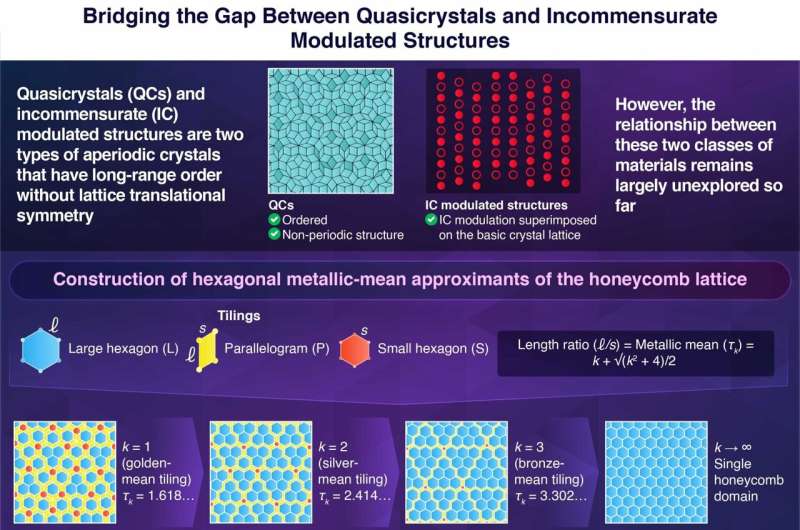
For a long time, scientists associated crystal structures with an ordered arrangement of atoms in a repeating lattice-like pattern, believing it to be the most stable configuration. However, by the 1960s, advancements in crystallography revealed materials that did not fit the traditional model. These structures exhibit a non-periodic or non-repeating pattern and are called aperiodic crystals.
There are two types of aperiodic crystals: quasicrystals (QCs), which exhibit ordered but aperiodic arrangements, and incommensurately (IC) modulated structures, where a three-dimensional periodic lattice structure is distorted by spatial variation or modulations. These materials possess properties distinct from those of ordinary periodic crystals, but the relationship between them remains largely unexplored.
In a study published in the journal Nature Communications, researchers led by Associate Professor Akihisa Koga from the Department of Physics at Tokyo Institute of Technology constructed a locally periodic honeycomb structure. They arranged small (S) and large (L) hexagonal as well as parallelogram (P) tiles in a two-dimensional space according to metallic means (generalizations of the well-known golden and silver ratios), introducing modulations to generate a honeycomb tiling pattern representing an incommensurately modulated structure.
“We present hexagonal metallic-mean approximants of the honeycomb lattice, which bridge the gap between quasicrystals and incommensurately modulated structures,” says Koga.
Aperiodicity is closely tied to the distance between the atomic positions in the crystal lattice. In quasicrystals, these distances are defined as irrational numbers locked by two-length scales, while in IC modulated structures, they are not fixed.
The researchers applied an aperiodic approximation to arrange the tilings within the crystal lattice. They varied the characteristic irrational in the lattice according to metallic means, such as the golden mean, silver mean, and bronze mean. Specifically, they arranged the tiles so that the ratio between the long length (representing the size of the large hexagon) and the short length (based on the side of the small hexagon and the parallelogram tile) corresponded to different metallic means.
Initially, arranging the tiles by taking the golden mean as the length ratio resulted in large hexagonal tiles bounded by parallelograms and smaller hexagonal tiles, creating an ordered but non-periodic quasicrystalline structure. However, as the metallic-mean ratio increased, the larger hexagonal tiles began to come together, forming honeycomb domains, considered as an IC modulated structure.
The researchers identified the metallic-mean tiling pattern in polymers using an ISP (I: polyisoprene, S: polystyrene, and P: poly(2-vinylpyridine)) triblock terpolymer. From the transmission electron microscope images of the polymer, they observed that the polymer arrangements could be represented by L, P, and S tiles with a regular region of L tiles at the center, and P tiles to its left. The P tiles were interpreted as twin boundaries marking the transitions between different orientations of the L tiles.
This tiling pattern was also observed in colloidal particles. The researchers simulated the behavior of 10,000 colloidal particles interacting with a Lennard-Jones-Gauss potential, finding that the ideal arrangement for the particles is a metallic-mean tiling, consisting of up and down triangles.
“Our study highlights the effectiveness of aperiodic approximants in inducing modulations within self-assembled soft-matter systems employing the P31m plane group. Specifically, we utilized the rows of P tiles as domain boundaries in the honeycomb lattice, thereby bridging metallic-mean hexagonal QCs and IC modulated honeycomb lattices,” says Koga.
“These findings provide insights into the realm of both aperiodic crystals and their broader implications for domain wall structures across various fields.”

